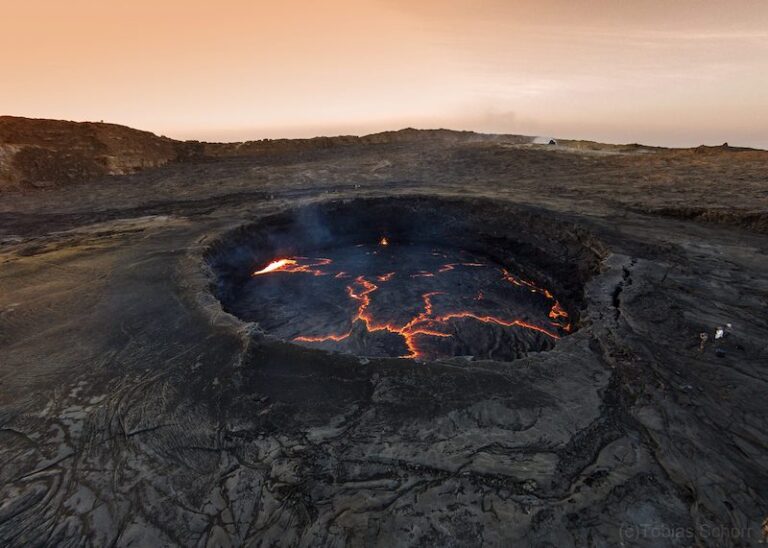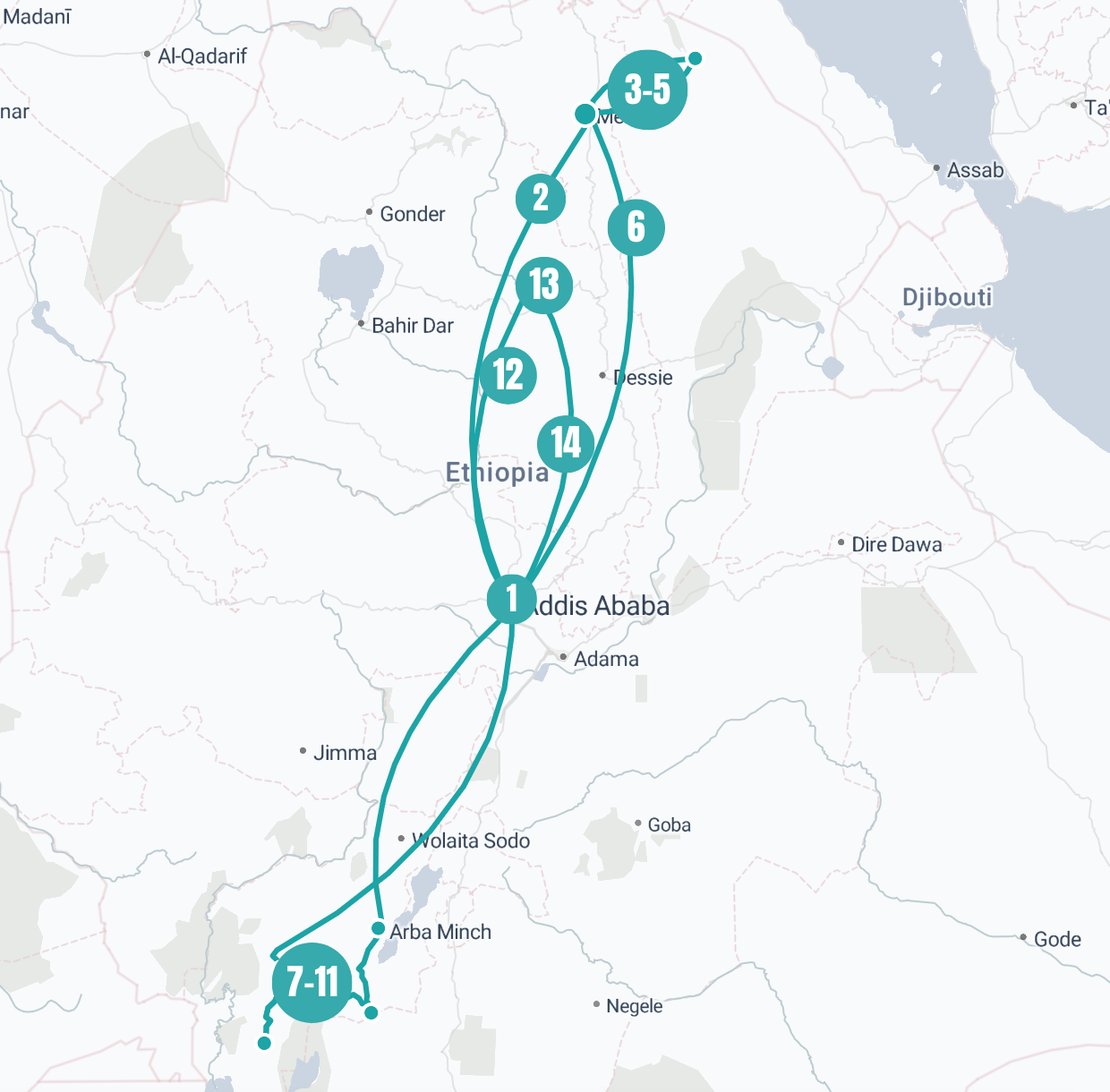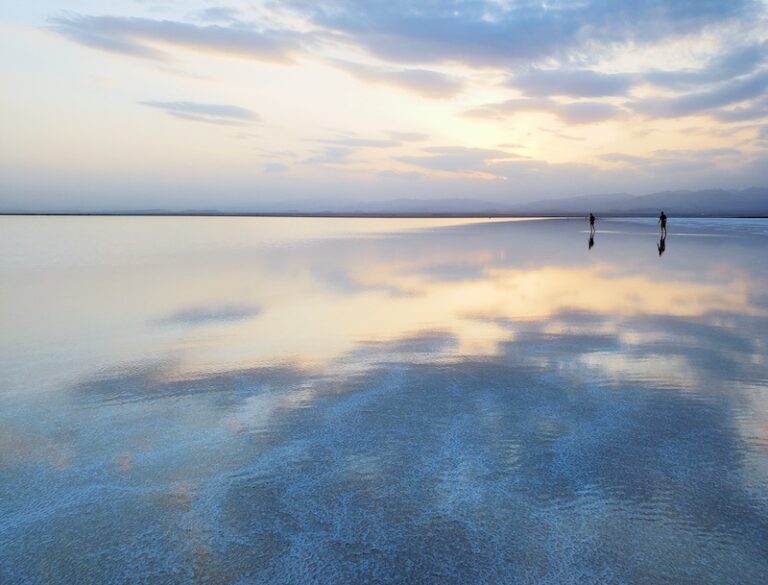Ethiopia
We traveled to Ethiopia right before the Tigray War. It was not an easy trip, but the alien-like landscape in the north, the body-painted tribes in the south, the ancient rock-hewn churches underground, and of course the coffee, the food, the richness of its culture and history free from colonization had totally wowed us. It is probably one of the most underrated countries in the world and one of the last where untapped beauty and originality is still readily accessible.
FULL ITINERARY
- Nature
- Culture
- Landmark
- Organized Tour
- Traveled in December 2019
- Day 1: Arrival in Addis Ababa
- Day 2: Flight to Mek'ele
- Day 3: Danakil Depression 3-Day Tour
- Day 4: Danakil Depression 3-Day Tour
- Day 5: Danakil Depression 3-Day Tour
- Day 6: Flight to Addis Ababa
- Day 7: Omo Valley 5-Day Tour
- Day 8: Omo Valley 5-Day Tour
- Day 9: Omo Valley 5-Day Tour
- Day 10: Omo Valley 5-Day Tour
- Day 11: Omo Valley 5-Day Tour
- Day 12: Flight to Lalibela
- Day 13: Lalibela
- Day 14: Flight to Addis Ababa & Departure
Day 1
Arrival
Arrive at Addis Ababa | Overnight in Addis Ababa
9:30 pm
Arrival
Most likely, an international arrival at Addis Ababa will not be timely enough for you to make it to another regional flight on the same day. We had to use Addis Ababa as an overnight base before heading out to different parts of country a lot during this trip. This is good because the capitol, in its efforts in becoming one of the most developed cities in Africa, gives us the much needed breather and connection with the West after each leg of the journey. We did not have time to explore this city on the first day of arrival, but had plenty of opportunities later on to enjoy its rich culture and history.
- Tips
- Exchange money at the ATMs in the baggage area at airport. They are labelled Zemen and Wegagen Bank.
- You can easily buy prepaid sim card at the airport or at telecom or convenient stores in the city.
- Expect hiccups and delays at the airport where assistance may not be easily attainable. Some airport staff messed up unloading the luggage from our flight, and we were left to our own devices at lost and found for hours before someone finally located them.
- Most hotels offer free airport pickup service. Downtown is only a few minutes’ drive away.
Day 2
Mek'ele
Arrive Mek'ele before heading out for Danakil Depression tour | Overnight in Mek'ele
10:00 am
Fly from Addis Ababa to Mek'ele
An hour easy flight from Addis Ababa, the capital of Tigray will inevitably be the base for all tours departing for Danakil Depression the next day. Most hotels offer free airport pickup.
12:30 pm
Lunch
2:00 pm
Mek'ele
We arrived a little after noon which gave us ample time for a leisurely stroll around our guesthouse after lunch. Bracing for the tough journey ahead and still recovering from the long day prior, we were not keen in seeking out any particular places of interest in this college town. This was actually our first real day in Ethiopia, so just watching regular folks chilling on a regular day fascinated us.
Less than a year after our visit, the Tigray War broke out. Some 600,000 civilian have died. The region has been under a blockade. I can’t imagine how the lives of the beautiful people we’ve met in Mek’ele have changed. Will they still be able to enjoy the sunshine in a backyard full of blooming flowers and lush greens while preparing food?
6:00 pm
Dinner
Day 3
Danakil Depression 3-Day Tour
Drive to Erta Ale and check out the lava lake on the summit at night | Overnight camping on the mountain
7:30 am
Drive from Mek'ele to Dodom
This 70 km drive took almost all day, traversing a vast expanse of desert and scattered villages, through bumpy and sometimes unpaved roads. It was an interesting ride however, as we got to dine with villagers, chase ostriches and watch sunset over lava field. The tour company we used is World Sun, a popular choice among travelers and from whom we’ve had a pretty good experience overall.
7:00 pm
Erta Ale
Settling down at the base of Erta Ale, one of the only five active volcanos in the world with a lava lake inside the crater, was our very romantic “camp under the stars” arrangement based on the tour description. It was not an untrue statement, but sleeping on rocks in sweaty clothes smelling sulfur in the air and fighting bugs wasn’t necessarily comfortable. We hiked to the crater once at night and once in the morning. The Gateway to Hell was frankly quite disappointing as the sulfur smoke was too strong both times that we could hardly see anything but a few red spots.
If the crater were clear of smoke, it should look like this. That would be something to see!

Day 4
Danakil Depression 3-Day Tour
Another look at Erta Ale lava lake before heading out to a salt flat | Overnight camping in Ahmed Ela
5:30 pm
Salt Flat
Not far from the camp site is a salt flat. I think the tour group spent too much time on the dry land taking turns dipping into a jacuzzi-sized natural pool. When we got to the wet flat, the sun was already setting. But what a sight! I instantly thought of the famous salt flats in Bolivia dubbed “Mirror of the Sky”. Wading in the thin layer of water with barely anything in sight but the faraway mountains and reflection of the sky, I wish I could stop the time.
7:30 pm
Day 5
Danakil Depression 3-Day Tour
Explore the bizarre landscape in Dallol and visit traditional salt miners before returning to Mek'ele | Overnight in Mek'ele
6:00 am
Dallol
I saw a picture of this place one day and decided that I must go there. It would be like walking on Mars
Sitting on convergence of three separating tectonic plates, Dallol is a hydrothermal system caused by rifting and volcanic activities. The hottest place on earth today is also the lowest volcanic field in the world as the place was once the bottom of the Red Sea. Littered with colorful hydrothermal pools, salt deposits, hot springs and miniature geysers, it’s a fascinating place to tourists for picturesque view as well as to scientists studying Martian environment and limits of life. With a water temperature of 89 degrees Celsius and acid level at pH 0.25, it’s probably the only place on earth with water but not even microorganism can survive. We were only able to be there in the early morning after a short drive from Ahmed Ela to avoid the extreme heat. And of course, there is no fence at this place yet even though the ever-changing pools and hot springs are deadly. Watch your steps.
9:00 am
Salt Mining
Despite the harsh environment in Danakil Depression, hundreds of Afar men still work laboriously with handaxes to extract salt from the lakebed everyday, in a temperature that can reach 50 degrees C (122 degrees F). They load the salt blocks on camels and trek 3-4 days to trade in the nearest city. Historians said this tradition has been going on since the 6th century. But with the opening of roads that brings along increased tourism and business investment, this only livelihood that these men know for generations may soon be lost.
10:00 am
Return to Mek'ele
The return trip took most of the day including lunch on the road. Finally, a hot shower!
6:00 pm
Dinner
Day 6
Flight to Addis Ababa
Return to Addis Ababa for the day | Overnight in Addis Ababa
12:00 pm
Flight from Mek'ele to Addis Ababa
This is another day of transit through Addis Ababa. Arriving in the early afternoon, we decided that we’d rather just chill and relax for the rest of the day.
6:00 pm
Dinner
You may inevitably come across music and dance entertaining dinner guests in a traditional Ethiopian restaurant. We totally enjoyed the food and the show at a restaurant called 2000 Habesha Cultural Restaurant near our hotel. It’s probably touristy and they even sang a Chairman Mao song in Chinese to a group of Chinese businessmen, another evidence of how much influence China has had in this country through its ambitious Belt and Road Initiative.


